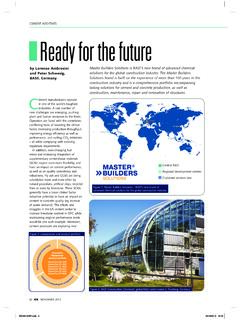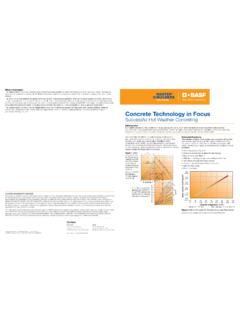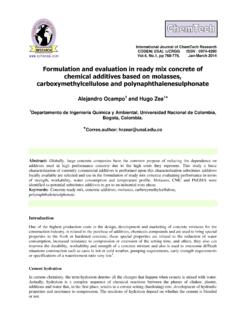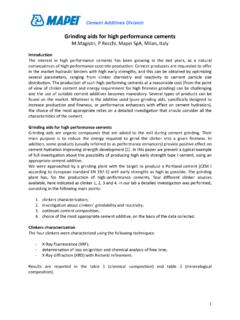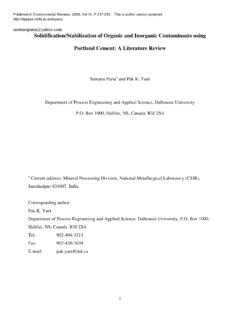Transcription of ADDITIVES IFuture role of cement additives - BASF
1 ADDITIVES ICR SEPTEMBER 2010 Simultaneously, end users are asking for higher cement performance and quality to realise more complex buildings, and durable infrastructure. Therefore, plant managers are faced with the conflicting tasks of increasing plant throughput, reducing costs, improving cement performance, and minimising emissions all while complying with regulatory requirements and internal quality standards. Technological evolution and society spur the industry to reflect upon the long-term evolution of cement production. What will be the future fuel mix? What are the limits of low-clinker cements? What is the potential for CO2 reduction? These and other topics are constantly discussed within the cement community, but are also increasingly debated by external stakeholders.
2 cement ADDITIVES suppliers are exploring the future role and the potential of innovative chemistry in cement production, by investing strongly in research the past, the majority of cement producers aimed for an additive-free optimisation of their cement manufacturing process. In most cases, cement ADDITIVES were seen as a corrective for insufficient process efficiency or product performance. Nowadays, cement ADDITIVES are to be found in virtually all European cement plants, and their use is increasing in emerging countries, thanks to the globalisation of the cement industry. cement producers are recognising the benefits of the addition of chemicals to cement grinding. However, a holistic approach that includes both comminution and chemical activation of cement components as an integrated process, would open new possibilities and allow them to reach new Construction Chemicals, building upon its recognised leadership in the field of concrete technology, is strongly committed to supporting cement producers in meeting their objectives with high-performance cement ADDITIVES .
3 The new Cementium product portfolio is rooted in BASF s rich experience with cementitious of cement additivesThe overall benefits of cement ADDITIVES comprise: cost reduction lower unit grinding energy greater integration of Supplementary Cementitious Materials (SCM) fewer capital expenditures due to increased capacity production efficiency higher mill throughput thanks to increased efficiency of grinding media and separators decreased pack-set, easier material handling and storage due to better fluidity of cement ; faster truck and ship loading reduced plant downtime due to less stoppages longer intervals between scheduled maintenance product differentiation higher early and late-age compressive strength better rheological behaviour of cement in concrete compensation for SCM drawbacks sustainability reduced electrical energy consumption lower clinker factor and CO2 emissions preservation of natural resources by extension of quarry lifespan.
4 BASF s research and development capabilities Traditionally, jar or other small mills are used for developing and testing cement ADDITIVES . For standard assignments this basic equipment fulfills most requirements. Although the data from lab mill tests gives indications about the performance trend of ADDITIVES , and suggests which product must be elected for full-scale trials. These results are far from realistic, and, therefore, not usable for further analysis. The most relevant deficiencies of a lab grinding test are: small ball size (low mechanical stress during comminution) and different ball size distribution, batch processing, low temperature, and absence of particles separation. To overcome these disadvantages, BASF decided to invest in a pilot mill in its regional development centre in IFuture role of cement additivesby Lorenzo Ambrosini and Attilio Camplone, BASF Construction Chemicals Europe AG The cement industry is going through a period of change producers are not only facing important challenges, but are also confronted with new opportunities.
5 cement plants are asked to constantly improve efficiency, while minimising their impact on the environment. Overall benefits of cement ADDITIVES reduced unit grinding energy higher integration of SCM capacity extension lower clinker factor and CO2 emissions extending the life-span of quarries higher product performance better cement rheological properties in concrete higher mill throughput fewer plant stoppages higher production between scheduled maintenance intervals better cement conveyanceAdded valueADDITIVESSEPTEMBER 2010 ICRT reviso, Italy. The pilot mill is a 1:10-scale reproduction of a cement ball mill, and allows reproduction of real manufacturing conditions, while avoiding the efforts that a full-scale grinding campaign demands.
6 The primary scope of the pilot mill is fundamental research and development of new cement ADDITIVES for the Cementium product portfolio. Although it is not part of the standard cement ADDITIVES implementation process in cement plants, upon detailed planning, the mill can also be used in specific projects with customers. Technical data of the pilot mill: 1:10-scale grinding plant in a dedicated building closed circuits, two-chamber ball mill dynamic separator mill temperature regulation airflow rate regulation mill performance evaluation and automatic feed control by noise measurement Programmable Logic Controller in a separated, noise-isolated control room. Advantages of the pilot mill: cement grinding and cement ADDITIVES dosage under steady-state process conditions dehydration of sulphate phases generation of a particle size distribution very similar to industrial cement , including over-grinding of soft materials real-time monitoring of the cement ADDITIVES effect on mill energy consumption and feed rate sufficient cement volume produced, allowing complete series of concrete tests (strength, ).
7 Beside the initial investment for the equipment and housing, the operation of the pilot mill requires dedicated resources, and a logistic set-up for reception, handling and storage of large volumes of raw materials and cements. Specific maintenance is needed, due to specific characteristics of the mostly tailor-made equipment. The pilot mill is a key element of BASF s cement ADDITIVES R&D capability, which consists of the central research centre in Trostberg, Germany, regional development centres, and numerous local customer service labs. It is complementary to a standard fully-equipped cement lab; the latter comprising of clinker crusher, jar mills, low-temperature grinding module APM, PSD laser analyser, ultrasonic-sieve, qualitative and quantitative crystallographic characterisation by XRD/Rietveld, elemental composition in solid state and pore solution and microscopy.
8 BASF s innovative activities in cement ADDITIVES can draw on a large team of chemists, physicists, mineralogists, geochemists, and civil engineers. Within the BASF Group, construction chemicals can rely on a global networked know-how of interdisciplinary research teams, which include around 1900 collaborative partnerships with universities, research institutes, start-up companies and industry partners. In 2009, the total number of employees involved in research and development rose to more then 9300, with expenditure amounting to BASF intends to maintain the same high intensity of R&D in 2010, despite the difficult economic is, and will become, a more integral part of cement production in the future, with a close cooperation between cement manufacturers and suppliers of chemical ADDITIVES being beneficial in overcoming future challenges.
9 Intensive activity is required in the development of the next generation of cement ADDITIVES , and with investment in both resources and equipment, and reliance on the Group s excellent global R&D network, BASF Construction Chemicals is committed in strongly supporting this evolution. ____IWater addition and mortar testLab jar millHeated lab millPilot mill (see main pic above) cement plantModelling a grinding process for implementation of cement additivesNew equipment for ADDITIVES development: the BASF pilot mill located in Treviso, ItalyInset: detail of the mill inlet and heating system
